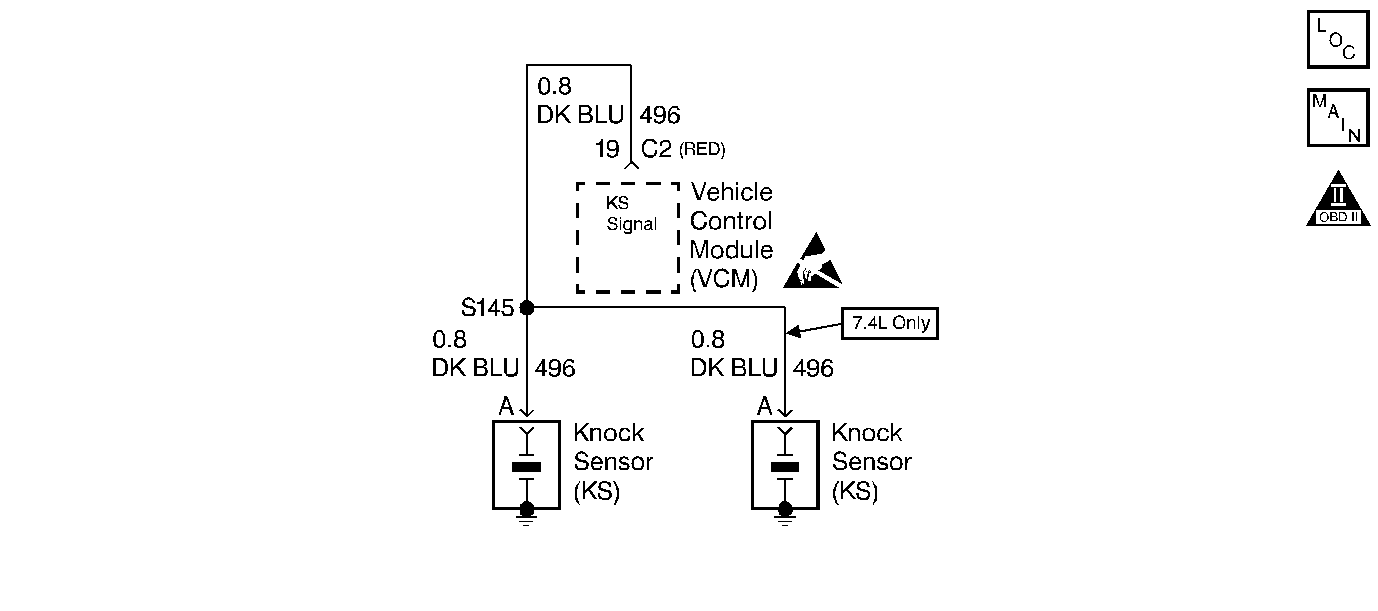
Circuit Description
The VCM uses the Knock Sensors in order to detect engine detonation. This detection allows the VCM to retard the Ignition Control (IC) spark timing based on the KS signal the VCM receives. The circuitry within the knock sensor pulls down the VCM-supplied 5 volt signal, so that under a no knock condition the signal on the KS circuit measures about 1.3 volts. The knock sensors produce an AC signal that rides on the 1.3 volts DC. The signal amplitude and frequency are dependent upon the amount of the knock being experienced.
The VCM contains a replaceable Knock Sensor (KS) module. The KS module contains the circuitry that allows the VCM to utilize the KS signal and to diagnose the KS sensors and circuitry. If the KS module is missing or faulty which causes a continuous knock condition, the VCM sets this DTC.
Conditions for Setting the DTC
| • | The DTC P0327 is not active |
| • | Engine run time is at least 120 seconds. |
| • | System voltage is greater than 10 volts but is no more than 17.1 volts. |
| • | The VCM detects a problem with the KS module circuitry that causes the knock to be indicated continuously |
| • | The above conditions met for up to 0.5 second |
Action Taken When DTC Sets
| • | The VCM will not illuminate the MIL |
| • | The VCM will store the conditions which were present when the DTC set as a Fail Records data only. This information will not store as Freeze Frame Data. |
| • | The VCM will use a calculated spark retard value in order to minimize the knock during the conditions when the knock is most likely to occur. The calculated value will vary based on the engine speed and load. |
Conditions for Clearing the MIL/DTC
| • | A history DTC will clear after 40 consecutive warm-up cycles have occurred without a fault |
| • | The scan tool Clear Info function or disconnecting the VCM battery feed can clear the DTC |
Diagnostic Aids
Check for the following conditions:
| • | A poor connection at the VCM. Inspect the KS module connector for the following conditions: |
| - | Backed out terminals |
| - | Broken locks |
| - | Improperly formed or damaged terminals |
| • | A damaged or improperly installed KS module. Check for the following items: |
| - | Bent pins |
| - | Deformed terminals |
| - | KS module not completely seated |
| • | Improper Knock Sensor torque specification. Torque the Knock sensor
to 19 N·m (14 lb ft). Refer to
Notice: Use the correct fastener in the correct location. Replacement fasteners must be the correct part number for that application. Fasteners requiring replacement or fasteners requiring the use of thread locking compound or sealant are identified in the service procedure. Do not use paints, lubricants, or corrosion inhibitors on fasteners or fastener joint surfaces unless specified. These coatings affect fastener torque and joint clamping force and may damage the fastener. Use the correct tightening sequence and specifications when installing fasteners in order to avoid damage to parts and systems. . |
Review the Fail Records vehicle mileage since the diagnostic test last failed in order to help determine how often the conditions that caused the DTC to set occur. This may assist in diagnosing the condition.
Test Description
The numbers below refer to the step numbers on the diagnostic table.
Step | Action | Value(s) | Yes | No |
|---|---|---|---|---|
1 |
Important: Before clearing the DTCs, use the scan tool to record freeze frame and failure records for reference because data will be lost when the Clear Info function is used. Was the Powertrain On-Board Diagnostic (OBD) System Check performed? | -- | Go to A Powertrain On Board Diagnostic (OBD) System Check | |
|
Important: If you can hear the engine knock, repair the engine mechanical problem before proceeding with this diagnostic.
Does the scan tool indicate the DTC P0325 Failed This Ign? | -- | |||
3 |
Does the scan tool indicate DTC P0325 test Failed This Ign? | -- | Refer to The Diagnostic Aids | |
4 |
Was a problem found | -- | ||
Was a problem found? | -- | |||
6 |
Does the scan tool indicate the DTC P0325 Failed This Ign? | -- | ||
7 | Replace the VCM. Important: If the VCM is faulty, the new VCM must be programmed. Refer to VCM Replacement/Programming (With KS Calibration PROM) . Is the repair complete? | -- | -- | |
8 |
Does the scan tool indicate that this diagnostic ran and passed? | -- | ||
9 | Using the scan tool, select Capture Info and Review Info. Are any DTCs displayed that have not been diagnosed? | -- | Go to The Applicable DTC Table | System OK |
